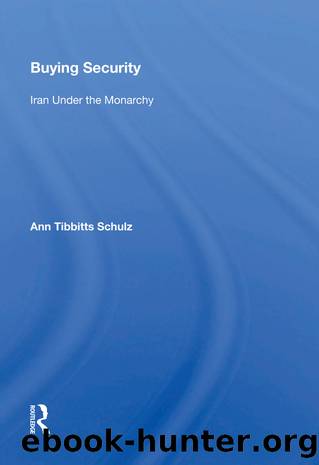Buying Security: Iran Under the Monarchy by Ann Tibbitts Schulz

Author:Ann Tibbitts Schulz [Schulz, Ann Tibbitts]
Language: eng
Format: epub
Tags: Public Policy, Middle Eastern, Social Science, Political Science, World, Military Policy, Regional Studies
ISBN: 9780429713552
Google: g96iDwAAQBAJ
Goodreads: 51860045
Publisher: Routledge
Published: 2019-04-08T00:00:00+00:00
a Firouz Toflq, âDevelopment of Iran: A Statistical Note,â in Jane W. Jacqz, ed., Iran: Past, Present and Future (New York: Aspen Institute for Humanistic Studies, 1976), p. 65.
b Bank Markazi, Annual Report and Balance Sheet 1975-76 (Teheran), p. 50. The series of figures for earlier years published in the Central Bank reports were higher than the figures that Tofiq presents, so the report data was used only where others were not available.
The increase in private capital formation from 1971 to 1975 was facilitated by the government's dramatically improved oil revenues. These revenues enabled the government to provide incentives to private sector investors in the form of supplemental financial capital for private projects and of joint public-private projects that were financially attractive. It is undoubtedly the case, too, that the prospects for future economic growth made investments look attractive.
Private investment might have been still higher if the government had shifted some of its military budget directly into infra structural development projects that would improve the expected rates of return on investment. Those who think that military spending may contribute to economic growth often point to the possible civilian use of military infrastructure. Those kinds of spin-offs cannot, however, be assumed. Nor is there enough information available about the costs of providing civilian infrastructure through spin-offs from military investments.
As indicated in the previous chapter, the lack of internal transport was historically an impediment to the development of a national economy. During the 1970s, communications and transport investments in Iran were sizable. A high proportion of expenditures on communications were for the military (Table 4.3). Similar figures for transport are not available; certainly earlier, major transportation projects were military in origin. In one such case, during World War II, British engineers improved many kilometers of highways in Iran in order to transport munitions to the Soviet forces in the north.12 The decisions about which highways to develop were made according to military criteria, not those of internal trade.
Similarly, the United States undertook to move the main railroad line during the war because it was not suitably located for military transport, and invested in approximately 180 locomotives and more than five thousand freight cars to add to the railroad's rolling stock. After the war, the railroad fell into disuse because it had no major role in civilian transport. Instead, the Iranian government channeled development funds into roads and highways. A number of the roads were primarily for military use, most clearly those that led north from the Gulf, parallel to the Iraqi border. That region, for the most part, is relatively sparsely populated. The roads' military value was that they provided access to an insecure border and to Kurdish and Luri tribal territories. From a security standpoint improving these roads was a logical step; however, the existence of additional kilometers of improved roads could not be counted as an increase in civilian economic infrastructure equal to road improvements that could have been made in other localities.
Iran's experience during the oil boom indicates that
Download
This site does not store any files on its server. We only index and link to content provided by other sites. Please contact the content providers to delete copyright contents if any and email us, we'll remove relevant links or contents immediately.
The Secret History by Donna Tartt(18849)
The Social Justice Warrior Handbook by Lisa De Pasquale(12142)
Thirteen Reasons Why by Jay Asher(8796)
This Is How You Lose Her by Junot Diaz(6794)
Weapons of Math Destruction by Cathy O'Neil(6146)
Zero to One by Peter Thiel(5686)
Beartown by Fredrik Backman(5599)
The Myth of the Strong Leader by Archie Brown(5425)
The Fire Next Time by James Baldwin(5249)
How Democracies Die by Steven Levitsky & Daniel Ziblatt(5128)
Promise Me, Dad by Joe Biden(5087)
Stone's Rules by Roger Stone(5026)
A Higher Loyalty: Truth, Lies, and Leadership by James Comey(4845)
100 Deadly Skills by Clint Emerson(4840)
Rise and Kill First by Ronen Bergman(4704)
Secrecy World by Jake Bernstein(4646)
The David Icke Guide to the Global Conspiracy (and how to end it) by David Icke(4625)
The Farm by Tom Rob Smith(4438)
The Doomsday Machine by Daniel Ellsberg(4416)
